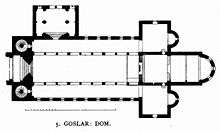Goslar Cathedral


The church known as Goslar Cathedral (German: Goslarer Dom) was the collegiate church of St. Simon and St. Jude in the town of Goslar in central Germany. It was built between 1040 and 1050 and stood in the district of the Imperial Palace of Goslar. It was demolished in 1819–1822. Today only the porch of the north portal remains. It was a church of Benedictine canons. The term Dom, a German synecdoche used for collegiate churches and cathedrals alike, is often uniformly translated as cathedral into English, even though this church here was a collegiate church, not a cathedral (seat of a bishop).
Design
The collegiate church was built to a standard design in the shape of a three-nave, initially flat-roofed basilica with an alternation of piers and columns. The walls were made of limestone blocks. It had a westwork with two low, octagonal towers and the main entrance and three eastern apses. The crypt was under the chancel. Above the crossing of nave and transept was another tower. The design of the collegiate church was the prototype for many subsequent church buildings of the Middle Ages.
History
The church was consecrated on 2 July 1051 by Archbishop Hermann of Cologne. At that time it was the largest Romanesque church east of the Rhine.
In the 12th century, the flat roof was replaced by a vaulted roof. Around 1200, the cathedral porch, now the only surviving part of the building, was added and the main entrance re-located here. In the Gothic period the church was extended to the north with a fourth nave and the chancel was altered.
Amongst the furnishings of the collegiate church were the bronze Krodo Altar and Imperial Throne of Goslar from the 11th century that have survived to the present day.
The church was dedicated to St. Simon and St. Jude whose saints day fell on the birthday of Emperor Henry III, who often stayed in Goslar.[2] He directed the building of the collegiate church. A few years later he founded the Church of St. Peter in Goslar which has not survived.[3]
By 1819 the collegiate church had fallen into ruin and, due to a lack of funding for its repair, was sold at auction to a craftsman who used it as "quarry" and had largely demolished it by 1822. Only the cathedral porch was preserved.
Local situation
The collegiate church was part of the palace district of the imperial and royal palace at Goslar. It was thus close connected with other buildings in the area like the Aula regia (Imperial Hall or Kaiserhaus), the Church of Our Lady (demolished), the Chapel of St. Ulrich and the Curia buildings that were all close together. Immediately adjacent to the collegiate church were the cloister and refectory, the chapter and the granarium (granary).
Significant historical events
- In 1056 Pope Victor II and Emperor Henry III met in Goslar and visited the church.
- In 1063 on the occasion of a princes' diet in Goslar there was an armed conflict in the church in the presence of Emperor Henry IV between the followers of the Bishop of Hildesheim and the Abbot of Fulda which resulted in some deaths. It became known as Goslar's Bloody Pentecost (also the Goslar Precedence Dispute)
- In 1154 Rainald of Dassel assumes the provostship.[4]
Sources
- Griep, Hans-Günther (1988). Goslar - Der Pfalzbezirk, Verlag Goslarsche Zeitung, Goslar
- Gutmann, Christopf and Schadach, Volker (2002). Kaiserpfalz Goslar, Verlag Volker Schadach, Goslar ISBN 3-928728-52-0
- Griep, Hans-Günther (1967). Goslars Pfalzbezirk und die Domkurien. Manuskript für die Mitglieder des Museumsvereins Goslar e.V., Goslar
References
- ↑ From: Dehio/von Bezold: Kirchliche Baukunst des Abendlandes. Stuttgart, 1887-1901.
- ↑ Gottlieb Friedrich Eduard Crusius: Geschichte der vormals kaiserlichen freien reichsstadt Goslar am Harze, Erste Lieferung, 1842, p. 30
- ↑ aaO p. 32
- ↑ Herkenrath, Rainer Maria: Reinald von Dassel, Reichskanzler und Erzbischof von Köln, Dissertation, Graz 1962
Coordinates: 51°54′11.7″N 10°25′40.1″E / 51.903250°N 10.427806°E